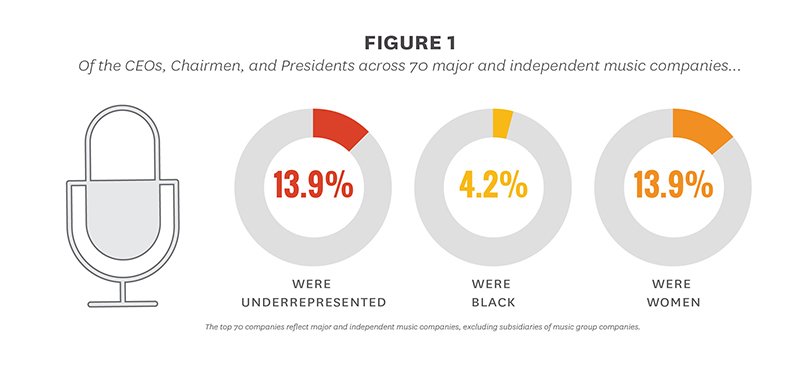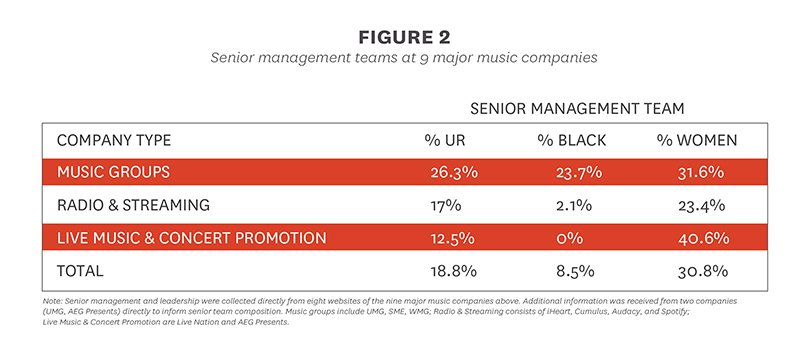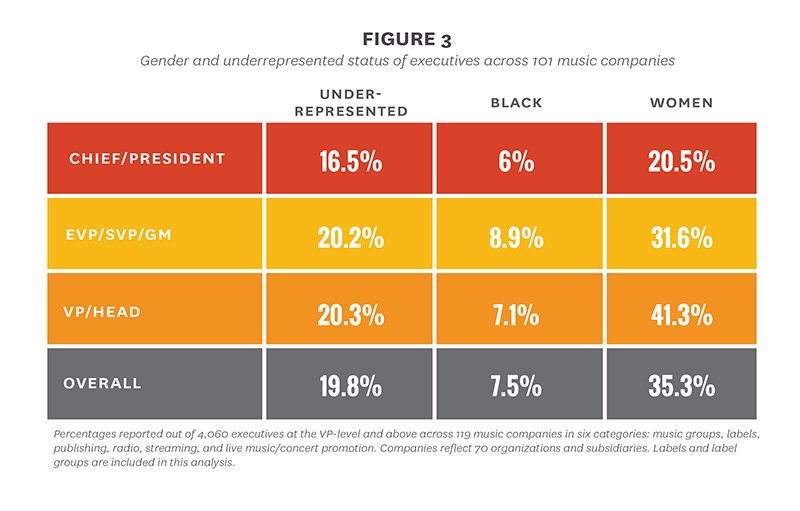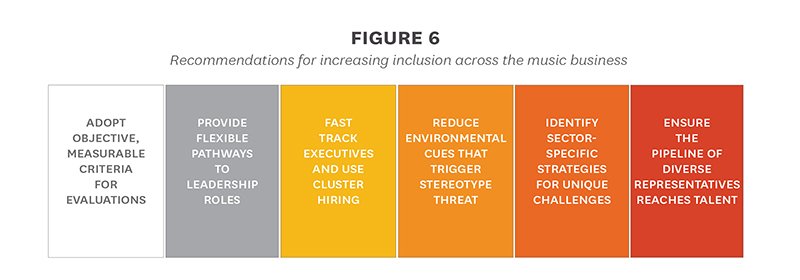Nearly half of the performers on the Billboard Hot 100 Year-End Charts over the last nine years were from underrepresented racial/ethnic groups. Yet, a comprehensive new report from the USC Annenberg Inclusion Initiative found that the executive ranks fall far short of the charts when it comes to underrepresented and Black executives.
The study is the first in a series from Stacy L. Smith, Carmen Lee and the Annenberg Inclusion Initiative to examine race/ethnicity and gender in the executive ranks in the music industry. Covering 4,060 executives from the vice president level to C-Suite roles across 119 companies and six industry categories — from music groups, labels and publishers to radio, streaming, live music/concert promotion — the results provide an authoritative snapshot of diversity in music’s decision-making roles.
Far from being only a diagnostic, the report invites the companies it reviewed to adopt industry solutions to increase inclusion in the executive ranks. To that end, the report is designed to illuminate the problem while inviting music companies from across the industry to the table in a collective effort for change. Sponsored by Universal Music Group, the report can be found online here.
“Getting to the proper solutions requires a proper diagnosis of the problem. That’s why this report is so fundamentally important to increasing inclusion in music’s executive ranks; it serves as a resource and demonstrates that there are inclusion deficits across the industry — whether in labels, publishing, streaming, radio, or live music,” said Smith, associate professor of communication. “Industry problems require industry solutions. Based on our analysis and our deep experience in the entertainment industries, we provide remedies that music companies of all types can use to improve their performance.”
“Diversity is not enough,” said Lee, clinical associate professor of communication. “That’s just the first step in an ongoing process towards enacting meaningful change. Our goal is to move the conversation beyond identifying the lack of diversity and extend it towards understanding inclusion and belonging in the workplace. We need to understand the barriers and challenges that impede inclusion and a sense of belonging for individuals working within the music industry, especially those from underrepresented communities. Our hope is that the industry will come together to tackle this problem in a way that creates meaningful progress.
Leadership positions lean toward white men
The study examined executive diversity in three ways: among CEOs and presidents across 70 major and independent companies; across senior management teams at nine major music companies; and in executive roles across 119 companies from the VP-level and above in six industry categories.
Beginning with the CEO, chair, and president roles across 70 major and independent music companies, 13.9% of top executives across were from underrepresented racial/ethnic groups, 4.2% were Black, and 13.9% were women. Unlike the majors, there were 10 underrepresented CEOs running independent companies across the music industry. However, only 2 of these were underrepresented women and only 3 were Black. (See Figure 1.)

Across the members of the senior management teams at nine major companies as shown on their websites, only 18.8% of executive board members were from underrepresented racial/ethnic groups, 8.5% were Black and 30.8% were women. (See Figure 2.) As a reminder, half of the U.S. population are women, 14% are Black, and 40% identify with an underrepresented racial/ethnic group. The leadership at top companies under-indexes relative to these data points. The researchers also point out that although the industry is centered on and profits from underrepresented artists, it is surprising that not one of the major music companies has an underrepresented CEO.

The composition of senior management teams varied by the type of company examined, however. Music groups (UMG, Sony Music Entertainment, Warner Music Group) had the greatest share of underrepresented (26.3%) and Black (23.7%) executives on their senior management teams. Live music and concert promotion companies (Live Nation, AEG Presents) had the fewest underrepresented (12.5%) executives and no Black senior management team members listed on their websites, but had the highest percentage of women team members (40.6%). Radio and streaming companies (iHeart Radio, Cumulus, Audacy, Spotify) held a middle ground between the other two categories: 17% of senior management team members were underrepresented, 2.1% were Black, and 23.4% were women.
“Underrepresented and Black artists are dominating the charts, but the C-suite is a ‘diversity desert,’” Smith said. “The profile of top artists may give some in the industry the illusion that music is an inclusive business, but the numbers at the top tell a different story.”
Inclusion is an industrywide problem
Looking more expansively at a broader range of decision-making roles revealed that the executive ranks are also exclusionary. Of more than 4,000 executives at 119 major and independent companies and their subsidiaries, 19.8% of executives at the VP-level and above were underrepresented, 7.5% were Black, and 35.3% were women. (See Figure 3.) Underrepresented and Black executives varied little from the VP/head level of employment to EVP/SVP/GM roles, or in chief/president positions.

For women, as power increased, the percentage of women in executive roles decreased significantly. However, this trend was primarily driven by white women’s presence in the executive ranks. More than one-quarter (26.9%) of all executives were white women, with only 8.4% underrepresented women, which includes 3% of executives who were Black women. White women filled 32.4% of VP/head roles, 23.3% of EVP/SVP/GM positions, but made up only 14.7% of CEO/chief/president spots. In contrast, underrepresented women filled fewer than 10% of all roles: 9.2% of VP/head roles, 8.2% of EVP/SVP/GM jobs, and 5.6% of CEO/chief/president slots. Black women filled even fewer spots: 3% of VP/head roles; 3.3% of EVP/SVP/GM jobs, and 2.4% of CEO/chief/president positions. The path to influence in music looks very different for white women and women of color.
The study makes a point to look broadly at the music industry to capture differences by category across music groups, labels, publishing, radio, streaming, and live music, demonstrating that the inclusion deficits are an industry-wide issue. Streaming companies, music groups and labels emerged as the leaders in hiring and promotion of underrepresented executives — a quarter of executive roles were held by underrepresented individuals — while only 12.3% of radio executives were from underrepresented racial/ethnic groups, the lowest across all categories. (See Figure 4.) There was little mobility for underrepresented executives toward CEO/chief/president roles.

Record labels were the only category where the percentage of Black executives (14.4%) reached proportional representation with the U.S. population. In every other category, the percentage was less than 10%: 7.4% in streaming, 7.2% in music groups, 6.1% in publishing, 4% in radio, and 3.3% in live music and concert promotion. These figures are startling, given that Black artists were 37.7% of all artists on the popular charts in the last nine years.
Turning to women executives, not one category reached 40%. Live music and concert promotion came closest (39.1%), but other categories (e.g., music groups, streaming, labels) were similar. Roughly one-third of all executives in radio (33.2%) and publishing (31.9%) were women.
Yet, examining women overall masked the erasure faced by underrepresented women. (See Figure 5.) Streaming had the highest percentage (12.5%) of underrepresented women executives, followed by music groups (11.4%) and labels (10.3%). The remaining categories (live music, 9%; publishing, 7.1%; radio, 4.4%) each had few underrepresented women in executive roles. While underrepresented women included the percentage of Black women executives, when this group was examined specifically, the percentages were even smaller. Labels had the highest percentage of Black women executives (5.3%), while only 1.4% of radio and 1.7% of live music executives were Black women. Across all categories, the ratio of white male executives to Black women executives is 17.7 to 1.

A&R reflects the industry’s possibilities
The study also shines a spotlight on one area that reflects the possibility for inclusion: artists and those who work with them. The researchers identified 1,750 solo artists signed to the labels investigated in the study. Of those, nearly half (48.3%) were from underrepresented racial/ethnic groups, 31.2% were Black, and 31.8% were women. The reason for music labels’ comparatively more inclusive performance also became clear when the artist & repertoire (A&R) executives were evaluated.
A full 34.2% of A&R executives across the three music groups and independent companies were underrepresented — which is close to proportional representation with the U.S. population — and 26.7% of all A&R executives were women.
Slightly less than a quarter (21.2%) of A&R executives overall were Black — above proportional representation to the population, but below the percentage of Black solo performers on the charts. Where companies still lag is for underrepresented women — less than 10% of all A&R executives were women of color and less than 5% of A&R executives were Black women (4.8%), although the presence of women of color on the popular charts has steadily increased in recent years.
Artists are surrounded by white representatives
A&R executives are only one facet of the teams that an artist might work with as they navigate the industry. The researchers narrowed the sample of artists to 242 individuals who had at least one song on the Billboard Hot 100 Year-End Chart over the last nine years. Then, the managers, agents and publicists who represented those established artists were scrutinized: a total of 321 managers, 243 agents, and 135 publicists. The inclusion profile varied by position. Nearly 40% of managers were underrepresented, and 30.8% of all managers were Black. These individuals were primarily men (27.7% underrepresented men vs. 11.2% underrepresented women), however. While 23.4% of managers were Black men, only 7.5% were Black women.
The profile of agents and publicists was lower than managers. Roughly one-fifth of agents (20.2%) and publicists (20.7%) were underrepresented, and only 11.1% of agents and 11.9% of publicists were Black. Nearly two-thirds (64.6%) of agents were white men while 51.9% of publicists were white women. Very few underrepresented women (4.5%) worked as agents for established artists. Moreover, only three Black women (1.2%) were responsible for the artists in this sample. Further, less than a tenth of all agents (9.9%) were Black men. Only six (4.4%) Black men worked as publicists and 10 (7.4%) Black women held this role for established artists.
Despite the percentage of Black and underrepresented established artists on the charts, the people who most closely manage their careers are largely white and often male. However, underrepresented and Black artists were far more likely than white artists to have team members whose identities were similar to their own. Roughly 80% of underrepresented and Black artists had at least one underrepresented or Black team member, compared to less than a quarter of white artists. Clearly, underrepresented and Black artists find it important to have team members from underrepresented backgrounds. Yet this leaves underrepresented and Black artists doing the work of inclusion for the entire industry. It’s time for the rest of the business, including white artists and executives to ensure that the pool of underrepresented talent in these roles has access and opportunity across the entire ecosystem.
The researchers offer several solutions to address disparities facing underrepresented, Black, and women executives across companies (see Figure 6). These remedies touch on global strategies for inclusion but are also specific to businesses. Additionally, the authors consider how to increase the presence of underrepresented and Black managers, agents, and publicists in music and emphasize the impact this can have for audiences.

